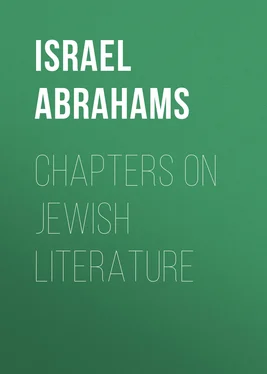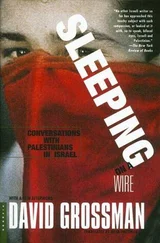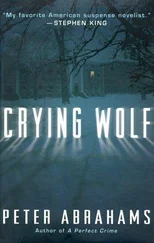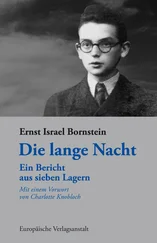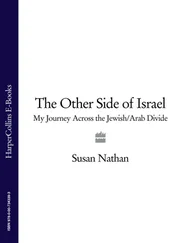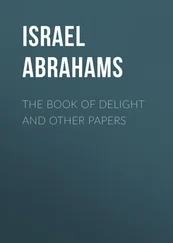Israel Abrahams - Chapters on Jewish Literature
Здесь есть возможность читать онлайн «Israel Abrahams - Chapters on Jewish Literature» — ознакомительный отрывок электронной книги совершенно бесплатно, а после прочтения отрывка купить полную версию. В некоторых случаях можно слушать аудио, скачать через торрент в формате fb2 и присутствует краткое содержание. Жанр: foreign_prose, foreign_antique, на английском языке. Описание произведения, (предисловие) а так же отзывы посетителей доступны на портале библиотеки ЛибКат.
- Название:Chapters on Jewish Literature
- Автор:
- Жанр:
- Год:неизвестен
- ISBN:нет данных
- Рейтинг книги:4 / 5. Голосов: 1
-
Избранное:Добавить в избранное
- Отзывы:
-
Ваша оценка:
- 80
- 1
- 2
- 3
- 4
- 5
Chapters on Jewish Literature: краткое содержание, описание и аннотация
Предлагаем к чтению аннотацию, описание, краткое содержание или предисловие (зависит от того, что написал сам автор книги «Chapters on Jewish Literature»). Если вы не нашли необходимую информацию о книге — напишите в комментариях, мы постараемся отыскать её.
Chapters on Jewish Literature — читать онлайн ознакомительный отрывок
Ниже представлен текст книги, разбитый по страницам. Система сохранения места последней прочитанной страницы, позволяет с удобством читать онлайн бесплатно книгу «Chapters on Jewish Literature», без необходимости каждый раз заново искать на чём Вы остановились. Поставьте закладку, и сможете в любой момент перейти на страницу, на которой закончили чтение.
Интервал:
Закладка:
It was Rab, however, who was the real popularizer of Jewish learning. He arranged courses of lectures for the people as well as for scholars. Rab's successor as head of the Sura school, Huna (212-297), completed Rab's work in making Babylonia the chief centre of Jewish learning. Huna tilled his own fields for a living, and might often be met going home with his spade over his shoulder. It was men like this who built up the Jewish tradition. Huna's predecessor, however, had wider experience of life, for Rab had been a student in Palestine, and was in touch with the Jews of many parts. From Rab's time onwards, learning became the property of the whole people, and the Talmud, besides being the literature of the Jewish universities, may be called the book of the masses. It contains, not only the legal and ethical results of the investigations of the learned, but also the wisdom and superstition of the masses. The Talmud is not exactly a national literature, but it was a unique bond between the scattered Jews, an unparallelled spiritual and literary instrument for maintaining the identity of Judaism amid the many tribulations to which the Jews were subjected.
The Talmud owed much to many minds. Externally it was influenced by the nations with which the Jews came into contact. From the inside, the influences at work were equally various. Jochanan, Rab, and Samuel in the third century prepared the material out of which the Talmud was finally built. The actual building was done by scholars in the fourth century. Rabba, the son of Nachmani (270-330), Abayi (280-338), and Rava (299-352) gave the finishing touches to the method of the Talmud. Rabba was a man of the people; he was a clear thinker, and loved to attract all comers by an apt anecdote. Rava had a superior sense of his own dignity, and rather neglected the needs of the ordinary man of his day. Abayi was more of the type of the average Rabbi, acute, genial, self-denying. Under the impulse of men of the most various gifts of mind and heart, the Talmud was gradually constructed, but two names are prominently associated with its actual compilation. These were Ashi (352-427) and Rabina (died 499). Ashi combined massive learning with keen logical ingenuity. He needed both for the task to which he devoted half a century of his life. He possessed a vast memory, in which the accumulated tradition of six centuries was stored, and he was gifted with the mental orderliness which empowered him to deal with this bewildering mass of materials.
It is hardly possible that after the compilation of the Talmud it remained an oral book, though it must be remembered that memory played a much greater part in earlier centuries than it does now. At all events, Ashi, and after him Rabina, performed the great work of systematizing the Rabbinical literature at a turning-point in the world's history. The Mishnah had been begun at a moment when the Roman empire was at its greatest vigor and glory; the Talmud was completed at the time when the Roman empire was in its decay. That the Jews were saved from similar disintegration, was due very largely to the Talmud. The Talmud is thus one of the great books of the world. Despite its faults, its excessive casuistry, its lack of style and form, its stupendous mass of detailed laws and restrictions, it is nevertheless a great book in and for itself. It is impossible to consider it further here in its religious aspects. But something must be said in the next chapter of that side of the Rabbinical literature known as the Midrash .
The Talmud.
Essays by E. Deutsch and A. Darmesteter (Jewish Publication Society of America).
Graetz.—II, 18-22 (character of the Talmud, end of ch. 22).
Karpeles.— Jewish Literature and other Essays , p. 52.
Steinschneider.— Jewish Literature , p. 20.
Schiller-Szinessy.— Encycl. Brit. , Vol. XXIII, p. 35.
M. Mielziner.— Introduction to the Talmud (Cincinnati, 1894).
S. Schechter.— Some Aspects of Rabbinic Theology, J.Q.R. , VI, p. 405, etc.
–– Studies in Judaism (Jewish Publication Society of America, 1896), pp. 155, 182, 213, 233 [189, 222, 259, 283].
B. Spiers.— School System of the Talmud (London, 1898) (with appendix on Baba Kama); the Threefold Cord (1893) on Sanhedrin, Baba Metsia , and Baba Bathra .
M. Jastrow.— History and Future of the Text of the Talmud ( Publications of the Gratz College , Philadelphia, 1897, Vol. I).
P.B. Benny.— Criminal Code of the Jews according to the Talmud (London, 1880).
S. Mendelsohn.— The Criminal Jurisprudence of the Ancient Hebrews (Baltimore, 1891).
D. Castelli.— Future Life in Rabbinical Literature, J.Q.R. , I, p. 314.
M. Güdemann.— Spirit and Letter in Judaism and Christianity , ibid. , IV, p. 345.
I. Harris.— Rise and Development of the Massorah , ibid. , I, pp. 128, etc.
H. Polano.— The Talmud (Philadelphia, 1876).
I. Myers.— Gems from the Talmud (London, 1894).
D.W. Amram.— The Jewish Law of Divorce according to Bible and Talmud (Philadelphia, 1896).
CHAPTER IV
THE MIDRASH AND ITS POETRY
Mechilta, Sifra, Sifre, Pesikta, Tanchuma, Midrash Rabbah, Yalkut.—Proverbs.—Parables.—Fables.
In its earliest forms identical with the Halachah, or the practical and legal aspects of the Mishnah and the Talmud, the Midrash, in its fuller development, became an independent branch of Rabbinical literature. Like the Talmud, the Midrash is of a composite nature, and under the one name the accumulations of ages are included. Some of its contents are earlier than the completion of the Bible, others were collected and even created as recently as the tenth or the eleventh century of the current era.
Midrash ("Study," "Inquiry") was in the first instance an Explanation of the Scriptures . This explanation is often the clear, natural exposition of the text, and it enforces rules of conduct both ethical and ritual. The historical and moral traditions which clustered round the incidents and characters of the Bible soon received a more vivid setting. The poetical sense of the Rabbis expressed itself in a vast and beautiful array of legendary additions to the Bible, but the additions are always devised with a moral purpose, to give point to a preacher's homily or to inspire the imagination of the audience with nobler fancies. Besides being expository, the Midrash is, therefore, didactic and poetical, the moral being conveyed in the guise of a narrative , amplifying and developing the contents of Scripture. The Midrash gives the results of that deep searching of the Scriptures which became second nature with the Jews, and it also represents the changes and expansions of ethical and theological ideals as applied to a changing and growing life.
From another point of view, also, the Midrash is a poetical literature. Its function as a species of popular homiletics made it necessary to appeal to the emotions. In its warm and living application of abstract truths to daily ends, in its responsive and hopeful intensification of the nearness of God to Israel, in its idealization of the past and future of the Jews, it employed the poet's art in essence, though not in form. It will be seen later on that in another sense the Midrash is a poetical literature, using the lore of the folk, the parable, the proverb, the allegory, and the fable, and often using them in the language of poetry.
The oldest Midrash is the actual report of sermons and addresses of the Tannaite age; the latest is a medieval compilation from all extant sources. The works to which the name Midrash is applied are the Mechilta (to Exodus); the Sifra (to Leviticus); the Sifre (to Numbers and Deuteronomy); the Pesikta (to various Sections of the Bible, whence its name); the Tanchuma (to the Pentateuch); the Midrash Rabbah (the "Great Midrash," to the Pentateuch and the Five Scrolls of Esther, Ruth, Lamentations, Ecclesiastes, and the Song of Songs); and the Midrash Haggadol (identical in name, and in contents similar to, but not identical with, the Midrash Rabbah ); together with a large number of collected Midrashim, such as the Yalkut , and a host of smaller works, several of which are no longer extant.
Читать дальшеИнтервал:
Закладка:
Похожие книги на «Chapters on Jewish Literature»
Представляем Вашему вниманию похожие книги на «Chapters on Jewish Literature» списком для выбора. Мы отобрали схожую по названию и смыслу литературу в надежде предоставить читателям больше вариантов отыскать новые, интересные, ещё непрочитанные произведения.
Обсуждение, отзывы о книге «Chapters on Jewish Literature» и просто собственные мнения читателей. Оставьте ваши комментарии, напишите, что Вы думаете о произведении, его смысле или главных героях. Укажите что конкретно понравилось, а что нет, и почему Вы так считаете.
